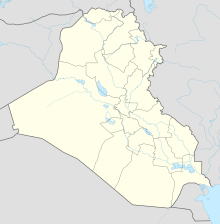Ennigaldi-Nanna's museum

Archeological excavations at the palace grounds
|
|
| Established | Circa 530 BCE |
|---|---|
| Dissolved | 5th century-BCE |
| Location | Ancient Ur |
| Coordinates | 30°57′42″N 46°06′19″E / 30.961667°N 46.105278°E |
| Type | Mesopotamian artifacts |
| Curator | Princess Ennigaldi |
Ennigaldi-Nanna's museum is thought to be the first museum by some historians, although this is speculative. It dates to circa 530 BCE. The curator was Princess Ennigaldi, the daughter of Nabonidus, the last king of the Neo-Babylonian Empire. It was located in the state of Ur, located in the modern-day Dhi Qar Governorate of Iraq, roughly 150 metres (490 ft) southeast of the famous Ziggurat of Ur.
When archaeologists excavated certain parts of the palace and temple complex at Ur they determined that the dozens of artifacts, neatly arranged side by side, whose ages varied by centuries, were actually museum pieces - since they came with what was finally determined to be "museum labels". These consisted of clay cylinder drums with labels in three different languages. Ennigalbi's father Nabonidus, an antiquarian and antique restorer, taught her to appreciate ancient artifacts. Her father is known as the first serious archeologist and influenced Ennigaldi to create her educational antiquity museum.
The palace grounds that included the museum were at the ancient building referred to as E-Gig-Par, which also had her living quarters. The palace grounds also included the palace subsidiary buildings.
When archaeologist Leonard Woolley excavated the ruins of the museum, its contents were discovered to be labeled, using tablets and clay drums. Many of the artifacts had been originally excavated by Nabonidus, Ennigald's father, and were from the 20th century BCE. Some artifacts had been collected previously by Nebuchadnezzar. Some are thought to have been excavated by Ennigald herself. The items were many centuries old already in Ennigald's time and came from the southern regions of Mesopotamia.
...
Wikipedia

